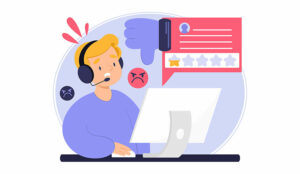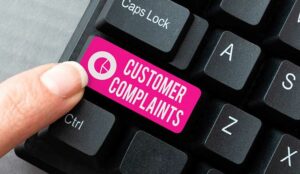Here are some tried and tested methods to help you improve your complaints-handling procedure and your resolution times.
1. Find out if general enquiries are being logged as complaints
It is important to get to the heart of what is being logged as a complaint in your contact centre.
If calls are being mislabelled as complaints – when they are actually just general enquires or customers closing an account as they’ve found a cheaper deal – you could be clogging up the system unnecessarily and delaying genuine complaints from being resolved.
An extensive call-listening exercise (listening to around 2,000 calls) should help you to get to the bottom of this. For example, one contact centre found that 25% of their total volume of complaints were the result of incorrect logging.
2. Empower the front line to feedback (and up) about what isn’t working
Front-line agents are a great source of insight into the issues that are driving customer complaints and how things could be improved.
A complaints feedback tool can harness this information and feed it back to the management team.
This information should be acted on and any changes (or reasons for not making changes) should be fed back to agents on the community forum.
3. Redesign your complaints training so everyone gets it right from day one
New starters can have a negative impact on the team’s complaint-handling performance if they are not fully up to speed on how things are done.
One way to resolve this is to make sure your complaints culture and procedure is firmly embedded in your agents from day one in the business.
Review your training and induction programmes to make sure everyone is on the same page.
4. Nominate “complaint buddies” to help departments communicate

Pairing up managers from different departments as “complaint buddies” can give individuals the single point of contact they need to reach the other department and get an issue resolved.
With an individual’s phone number or desk location, they provide immediate access for feedback on any situation as it develops without having to be passed from pit to post.
This can also help to address cross-site challenges of regular contact and support.
5. Tell your customers’ individual stories in the boardroom
It can be difficult to convince the board that a particular issue is driving up customer complaints, especially as statistics can quickly merge into each other in the board room.
However, highlighting a problem with a story about an individual’s experience can help personalise the issue and emphasise why it matters.
For example, “We had Mrs Smith on the phone yesterday crying about her lost parcel” could replace statistics about delivery problems.
6. Save time and money by empowering agents to issue immediate refunds
Some organisations are reluctant to empower their agents to issue refunds. However, they could be costing the organisation money by not doing so.
The agent immediately issuing a £40 refund for a broken vase is usually far easier and cheaper than escalating the issue through the formal complaints procedure – especially when you take the cost of everyone’s time into account.
Giving clear examples of scenarios where refunds or compensation is due can help agents understand where this is an appropriate response.
7. Hold individuals accountable for escalating calls
It doesn’t take much for a blame culture to develop between different areas of any business, especially if calls are being passed unnecessarily between departments.
One way to tackle this is to embed a culture of accountability.
For example, team leaders should take responsibility for the calls their agents are passing through to another department and review any case before it is escalated.
8. Ease the pressure by setting realistic expectations for your customers
If a call does require more information or follow-up activity, it is important that the agent sets clear expectations for the customer – even if it is to say that they will call back in 3 hours’ time.
This can help to ease the pressure on anyone else involved in resolving the issue, as they can finish their meeting before investigating the query thoroughly, instead of dropping everything to hurry back to the customer.
It can also stop a customer from phoning back unnecessarily and blocking the line for a new caller.
9. Gather once a month to discuss what isn’t working
A good way to keep track of the issues generating customer complaints in the business is to hold a Customer Forum once a month.
This is an opportunity for key individuals to gather and discuss the latest trends and data. This insight can then be driven back into the business via the responsible departments.
10. Swap your complaints email address for a complaints form

A generic complaints email address on your website can attract a large number of emails about generic issues instead of complaints.
(One contact centre found that 90% of emails coming through on this address were about general service issues and weren’t actually complaints.)
It can take up a lot of time to sort these emails into complaints and non-complaints and forward them to the relevant departments.
One way to resolve this is to swap your complaints email address for a specific complaints form on the website.
You will also have the opportunity to shape the information you gather by the questions you ask, making it easier to resolve the query once it comes through.
11. Make sure “customers come first” is a clear focus at all levels
A lot of managers think that they have a “customers come first” message at the heart of their business but don’t have a firm grasp of how this filters down to the front line.
Unintentionally, the message gets diluted or intercepted by the introduction of different metrics and targets.
One way to overcome this issue is to align your quality scorecards and objectives with the needs of the customer.
This can also help improve employee engagement, as agents understand exactly how they help the customer.
12. Target on First Contact Resolution (FCR) to break the habit of call escalation
It is easy for agents to fall into the “knee-jerk” habit of escalating trickier calls – even if it isn’t the best solution for the customer or the department the call is being passed to.
Targeting agents on metrics such as First Contact Resolution (FCR) can help agents really think about how to resolve that customer’s query without escalating.
13. …And monitor “unnecessary referrals”
If you are finding that a lot of calls are being referred to another department or escalated without due cause, introducing an “unnecessary referrals” metric can help to address this.
This is a far more relatable approach for the agent and team leader when compared with pinning down First Contact Resolution rates.
This metric assesses all referred calls to determine how many of those could have been handled without any escalation. Feedback is then given on a weekly and monthly basis.
14. Give everyone the information they need to do their job properly

There is no good to be gained by saying “don’t pass these calls through to me” and walking away.
(This applies both to team leaders training their agents and team leaders developing their relationships with external departments.)
Instead, take the time to ask “what do you need to achieve this” and then work together to deliver the necessary training and materials.
A really helpful aid is a reference guide of real-life examples and what to do in that situation – without getting anyone else involved. It can also help to have regular meetings to make sure this knowledge bank is as effective and up to date as it can be.
Sharing knowledge is key to success.
15. Put adaptive processes in place to help you adapt to changing customer needs
Design your processes so that they can be easily tweaked to suit the changing needs of your customers.
You should never be delivering a bad customer experience just because “it’s too hard to change the process”.
For more advice on delivering a great customer experience, read our article: 18 Tried and Tested Ways to Improve the Customer Experience
16. Tie key metrics together across different departments
Different departments are often unaware of the negative impact they may be having on one another. Even if they are, they can be reluctant to change anything that isn’t directly impacting on their own performance.
Encourage everyone to be more conscientious of their behaviour by tying key metrics together across the different departments.
17. Don’t be too strict with your reason codes
If you are too specific with your reason codes, it can be hard for agents to decide what goes where. This can lead to calls being tagged incorrectly.
Try giving agents guidelines instead of rules to clarify what your big problems really are.
18. Make it easy for your customers to complain
How easy is it to complain to your organisation?
If your customers have to dig through pages of your website to find a buried phone number, you are making life difficult for everyone.
- You are creating another frustration for your customers, on top of the problem they are already trying to contact you about.
- You are depriving your organisation of valuable insight that could help to drive key improvements in your business.
- You are inviting more complaints to your social media feed, as this is a last-resort channel for many people.
Remember, a complaint is proactive feedback from the customer!
19. Establish which agents are generating the most complaints
Complaints don’t come out of nowhere.
Measuring the competency of both individuals and departments – in regard to the numbers of complaints they each generate – can help you address the key issues that are contributing to the volume of complaints.
For example, recurring delivery problems in a particular area, or agents forgetting (or not knowing how) to set customer expectations in line with any given outcome.
20. Give your complaints team control of social media

A large proportion of customer tweets are complaints-related, so it makes sense for your complaints team to be in control of this channel instead of dealing with escalations from other departments.
Due to the sensitive nature of some issues, it usually helps to quickly move the conversation offline or into a Direct Message (DM).
The main exception to this is serial complainers, who often seek attention long after their complaint has been dealt with.
A public response can help show your other customers that you have resolved the issue, and (hopefully) send the serial complainer on their way.
21. Don’t prioritise one channel over another
Make sure all complaints – even those coming in by letter – are handled with equal importance.
It can help to allocate specific people to emails and letters to ensure they are also handled in a timely manner.
This can stop duplicate complaints coming in on different channels, as customers try and work out which channel will get the fastest response.
Find out more ideas for handling customer complaints in our article: 20 Great Ways to Drive Down Customer Complaints
With thanks to:
- Tesco Bank Insurance
- Stephen Thurlow at Verint
- The Call Centre Management Association (CCMA)
Author: Jo Robinson
Reviewed by: Megan Jones
Published On: 13th Apr 2016 - Last modified: 25th Mar 2024
Read more about - Hints and Tips, Call Handling, Communication Skills, Complaints, Customer Experience (CX), Empowering Agents, Handling Customers, Training and Coaching, Verint Monet










































make it really easy and fast for an agent to record every customer whinge from every channel, including social, and have a separate team log and investigate and manage them. invest in reporting to enable views of trends over time, and follow through.
remember the hard truth that it you will have a fr more loyal customer if you resolve their complaint rather than avoid recording it